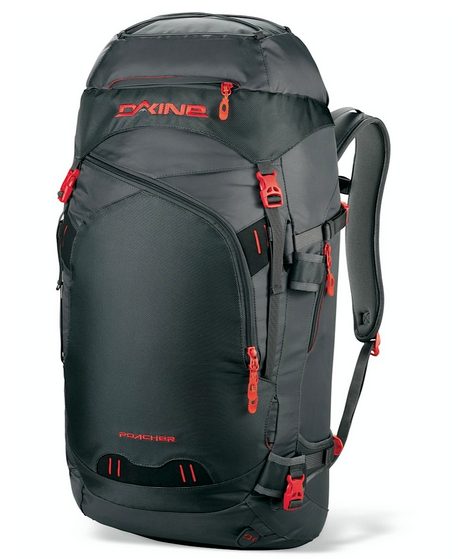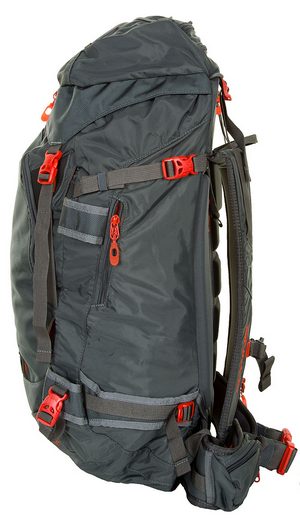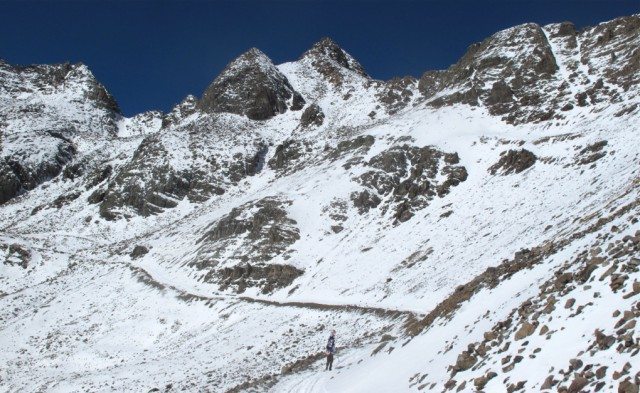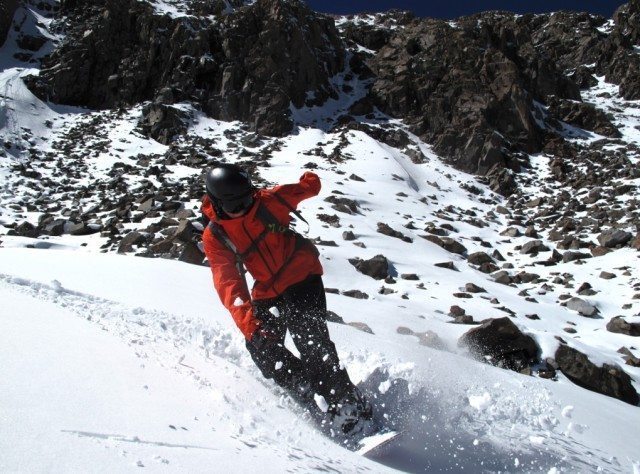
Dakine Poacher 45L
Volume: 45L (2743 in3)
Dimensions: 71 x 30 x 28 cm (28 x 12 x 11 in)
Weight: 1.7kg (3.7 lbs)
Stated Features:
- Vertical snowboard carry
- Retractable cable ski carry
- Dedicated A-frame ski carry
- Deployable helmet carry
- Insulated hydro sleeve
- Quick draw ice axe sleeve
- Load compression straps
- Integrated rescue whistle / sternum strap
MSRP: $175
Days Tested: 8
I’ve consistently been impressed by Dakine packs and bags, so I had very high expectations for the Poacher.
At 45 liters, it’s definitely a relatively large backcountry shred pack, and while Dakine doesn’t specify the intended uses of the Poacher, it’s likely meant for long tours and ski / snowboard mountaineering.
Features
The Poacher 45L is sleek, well-designed, and loaded with useful features. I immediately noticed the back-panel zippers that allow access to the main pocket without having to open the top. The top of the Poacher uses a system similar to what you’d find on most backpacking packs—two buckles wrap around the “brain” of the pack, and there’s a cinching section that lets you add volume as needed.

The dedicated avalanche gear pocket on the outside of the pack seems well-placed and easy-to-access. It’s large enough to accommodate the blade of a shovel (you can store the handle on the side) and a probe, without much spare room. The material inside the pocket isn’t particularly tough, so I’d hesitate before storing crampons or other spiky gear in there.
The Poacher’s numerous straps, while functional, are very long. It seems like some straps could stand to lose 8-12 inches without sacrificing functionality, but this issue is easy to remedy with scissors and a lighter.

On the Trail
The first time I used the Poacher was during the summer. I was packing for a one-nighter in Little Cottonwood Canyon, and my 85L Osprey Argon was too much pack for that particular trip. After that trip, and a few more short backpacking excursions, I realized that the Poacher is completely capable as a summer pack, and that it’s much more versatile than advertised.
I was able to pack my MSR Hubba Hubba 2-man tent, a pot, a small amount of food, sleeping bag, pad and layers in the main pocket. I found that the Poacher definitely holds at least 45L.
My only complaint after multiple summer trips is that my back got slightly sweatier with the Poacher than if I’d been wearing a summer-specific pack, but that’s not surprising, and it isn’t a big deal for me. I fully intend to use this bag year-round in the future.
In late September, the Aspen area was hit by an early snowstorm, and reviewer Julia Van Raalte and I went to start our seasons off right. The trek to the Montezuma snowfield under Castle Peak required about a 5-mile hike on dirt that was covered by a few inches of snow.

I wore my hiking boots and pants on the way up, and packed my entire kit—boots, board, jacket, pants, layers, and gloves—in the Poacher’s main pocket, with a shovel in the outer compartment and my helmet under the deployable elastic helmet holder on top. The vertical snowboard carry straps are tucked into their own storage pouches, and were easy to use.
I would conservatively guess that I had about 30 pounds of gear in the pack (significantly less than I’d had during the summer), and I definitely didn’t feel like I was maxing out the suspension system. The hip belt is comfortable, and it’s stronger than the standard hip belt you’d find on a smaller backcountry pack.
A standard 3L Camelbak bladder integrates nicely with the Poacher, which has an insulated sleeve for the nozzle to run down the shoulder strap. After gearing up at the top, I tightened the compression straps on the side and found that riding with the pack nearly empty wasn’t bad at all—I never felt the pack sway from side to side. I have a pretty long torso, and the pack never felt like it wasn’t the right size for my back.

Bottom Line (For Now)
Though I haven’t been on a full tour with the Poacher (I’ll update this review when I have a good idea of how it performs during those longer trips), I believe that it will be a solid pack for high-volume use. And I’m eager to see how it manages loads for multi-day expeditions.
